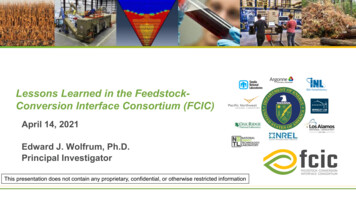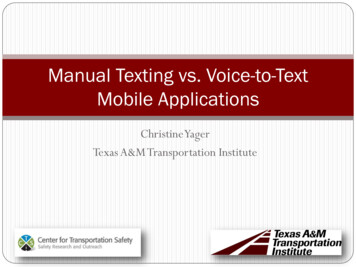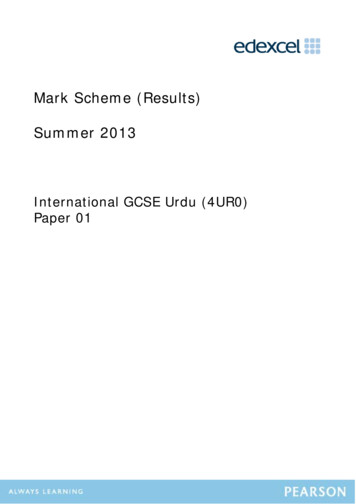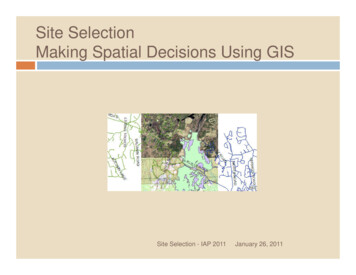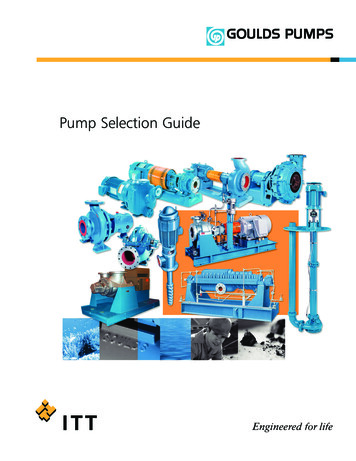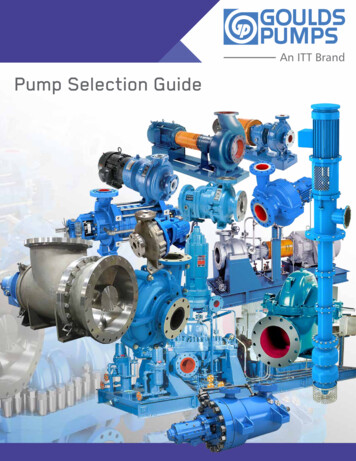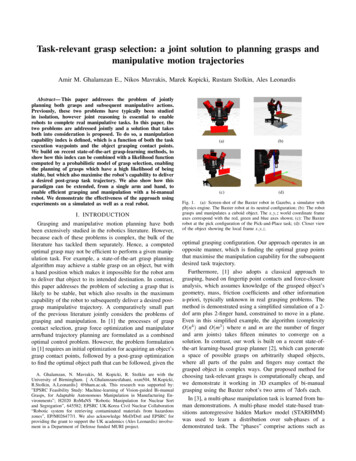
Transcription
Task-relevant grasp selection: a joint solution to planning grasps andmanipulative motion trajectoriesAmir M. Ghalamzan E., Nikos Mavrakis, Marek Kopicki, Rustam Stolkin, Ales LeonardisAbstract— This paper addresses the problem of jointlyplanning both grasps and subsequent manipulative actions.Previously, these two problems have typically been studiedin isolation, however joint reasoning is essential to enablerobots to complete real manipulative tasks. In this paper, thetwo problems are addressed jointly and a solution that takesboth into consideration is proposed. To do so, a manipulationcapability index is defined, which is a function of both the taskexecution waypoints and the object grasping contact points.We build on recent state-of-the-art grasp-learning methods, toshow how this index can be combined with a likelihood functioncomputed by a probabilistic model of grasp selection, enablingthe planning of grasps which have a high likelihood of beingstable, but which also maximise the robot’s capability to delivera desired post-grasp task trajectory. We also show how thisparadigm can be extended, from a single arm and hand, toenable efficient grasping and manipulation with a bi-manualrobot. We demonstrate the effectiveness of the approach usingexperiments on a simulated as well as a real robot.I. INTRODUCTIONGrasping and manipulative motion planning have bothbeen extensively studied in the robotics literature. However,because each of these problems is complex, the bulk of theliterature has tackled them separately. Hence, a computedoptimal grasp may not be efficient to perform a given manipulation task. For example, a state-of-the-art grasp planningalgorithm may achieve a stable grasp on an object, but witha hand position which makes it impossible for the robot armto deliver that object to its intended destination. In contrast,this paper addresses the problem of selecting a grasp that islikely to be stable, but which also results in the maximumcapability of the robot to subsequently deliver a desired postgrasp manipulative trajectory. A comparatively small partof the previous literature jointly considers the problems ofgrasping and manipulation. In [1] the processes of graspcontact selection, grasp force optimization and manipulatorarm/hand trajectory planning are formulated as a combinedoptimal control problem. However, the problem formulationin [1] requires an initial optimization for acquiring an object’sgrasp contact points, followed by a post-grasp optimizationto find the optimal object path that can be followed, given theA. Ghalamzan, N. Mavrakis, M. Kopicki, R. Stolkin are with theUniversity of Birmingham. { A.Ghalamzanesfahani, nxm504, M.Kopicki,R.Stolkin, A.Leonardis} @bham.ac.uk. This research was supported by:”EPSRC Feasibility Study: Machine-learning of Vision-guided Bi-manualGrasps, for Adaptable Autonomous Manipulation in Manufacturing Environments”; H2020 RoMaNS “Robotic Manipulation for Nuclear Sortand Segregation”, 645582; EPSRC UK-Korea Civil Nuclear Collaboration“Robotic system for retrieving contaminated materials from hazardouszones”, EP/M026477/1. We also acknowledge MoD/Dstl and EPSRC forproviding the grant to support the UK academics (Ales Leonardis) involvement in a Department of Defense funded MURI project.(a)(b)(c)(d)Fig. 1. (a): Screen-shot of the Baxter robot in Gazebo, a simulator withphysics engine. The Baxter robot at its neutral configuration; (b): The robotgrasps and manipulates a cuboid object. The x, y, z world coordinate frameaxes correspond with the red, green and blue axes shown; (c): The Baxterrobot at the pick configuration of the Pick-and-Place task; (d): Closer viewof the object showing the local frame x, y, z.optimal grasping configuration. Our approach operates in anopposite manner, which is finding the optimal grasp pointsthat maximise the manipulation capability for the subsequentdesired task trajectory.Furthermore, [1] also adopts a classical approach tograsping, based on fingertip point contacts and force-closureanalysis, which assumes knowledge of the grasped object’sgeometry, mass, friction coefficients and other informationa-priori, typically unknown in real grasping problems. Themethod is demonstrated using a simplified simulation of a 2dof arm plus 2-finger hand, constrained to move in a plane.Even in this simplified example, the algorithm (complexityO(n4 ) and O(m3 ) where n and m are the number of fingerand arm joints) takes fifteen minutes to converge on asolution. In contrast, our work is built on a recent state-ofthe-art learning-based grasp planner [2], which can generatea space of possible grasps on arbitrarily shaped objects,where all parts of the palm and fingers may contact thegrasped object in complex ways. Our proposed method forchoosing task-relevant grasps is computationally cheap, andwe demonstrate it working in 3D examples of bi-manualgrasping using the Baxter robot’s two arms of 7dofs each.In [3], a multi-phase manipulation task is learned from human demonstrations. A multi-phase model state-based transitions autoregressive hidden Markov model (STARHMM)was used to learn a distribution over sub-phases of ademonstrated task. The “phases” comprise actions such as
approaching the object with the left and right arm of ahumanoid robot, grasping, lifting and moving the object.A set of motor primitive policies are then learned for eachphase of the task, and reinforcement learning is used to makethe transition between phases. This approach thus considersgrasping and subsequent manipulative motion as two separatestages, and the example task included execution of graspingand manipulation, but with no dependency or optimizationbetween the two actions. In contrast, our paper shows howto choose the grasp positions specifically so as to improvethe robot’s ability to perform the subsequent manipulativeactions.For the problem of grasping, a variety of grasp planningapproaches have been proposed. One category of methods[4], [5] includes those which search for shapes on the objectthat fit within the robot gripper. Another category of methodsincludes those that allow the robot to learn a mappingbetween visual input and action [6]. The latter case hasbeen examined in [2], where a probabilistic approach wasproposed for providing a robot with a space of likely grasps.The approach of [2] models the hand configuration withrespect to the shape of the object using a single demonstratedgrasp example. The learned model is a product of twokernel density functions: a density over the pose of a singlehand link relative to the local object surface, and a densityover the whole hand configuration. This approach capturesthe local relation between hand and object shape, resultingin an optimal grasp. However, as far as manipulation isconcerned, the computed grasp may lack performance interms of manipulation capability.For the problem of measuring manipulation capability,measuring indices such as manipulability and reachabilityhave been specifically considered in the context of dualarm manipulation, with motivation stemming from the needto manipulate bulky and heavy objects. Zacharias et al. [7]presented an efficient way of assessing the reachability ofdifferent parts of the workspace, and used this to help choosean easiest-to-reach grasp position. Vahrenkamp et al. [8]showed how a robot holding an object in one hand, couldefficiently move its other hand to achieve a bi-manual grasp.In contrast to our work, both of these methods relied onpre-programmed grasps already being known a-priori fora specific object. Neither of the methods explained howto choose grasps to facilitate a specific desired post-graspmanipulative motion. [9] and [10] extended this work byintroducing new measures of manipulability, and showinghow they could be used to choose bi-manual grasps resultingin highly manipulable configurations. However, these laterworks also relied on a database of pre-known grasps for eachobject, and also did not address the main problem tackled inthis paper, namely how to plan grasps which are chosen soas to facilitate a specific desired post-grasp task motion. Incontrast, [9], [10] proposed an optimal grasp resulting in amaximum manipulability at initial grasp configuration.The main contributions of this paper are as follows: we propose new measures of manipulation capabilitywhich are specific to a particular desired task trajectory; we show how this approach can be extended fromuni-manual to bi-manual or multi-arm grasping andmanipulation problems;we demonstrate the usefulness of the proposed approach, using both uni-manual and bi-manual examplesof pick-and-place and pick-rotate-place tasks with theBaxter robot.II. L EARNING AND GENERATION OF GRASPS FORARBITRARILY SHAPED OBJECTS[2] showed how grasp models can be trained using onlya single demonstrated grasp on a single object, but enablenew grasps to be computed for new objects of arbitraryshape. This grasp learning and generation approach relieson probabilistic modelling of surface features, extracted from3D depth images. The surface features x SE(3) R2 consistof curvature r R2 and a local frame attached to surfacepoint gc x SE(3), where SE(3) denotes the group of 3Dposes (3D position p and 3D orientation q). SE(3) R3 SO(3) and SO(3) R3 3 denotes the group of rotations inthree dimensions:SO(n) {R Rn n : RRT I, det(R) 1}.The object model is defined as a joint probability distributionof a set of features, modelled as kernel density estimation:O(gc x, r) pdfo (gc x, r) 'K0 w jKgcx, r x j , σx j 1where w jKgc R are kernel weights, and x, r x j , σx N3 (p µ p , σ p )θ (q µq , σq )N2 (r µr , σr )µ and σ are the kernel mean and kernel bandwidth. N is an variate isotropic Gaussian kernel, and θ is a Gaussian-likedistribution in SO(3).Contact model pdfMi (u, r) encodes the joint probabilitydistribution of surface features and of the 3D pose of theith hand link, where ui j v 1j si , si and denote the poseof Li and the composition operator. The contact model oflink Li isBi (u, r) 1ZK0 N3 (p µ p , σ p )θ (q µq , σq )N2 (r µr , σr )(1)j 1where Z R , ui j (pi j , qi j ) is the pose of link Li relativeto the pose of v j of the jth surface feature.Hand configuration model C weights the space of handconfigurations to favour configurations most similar to thoseobserved during training. C is constructed as a kernel densityas follows: C (hc ) w(hc (γ))N hc hc (γ), σcwhere, w(hc (γ)) exp( αkhc (γ) hgc k2 ), α is a real positive value, hc (γ) (1 γ)hgc γhtc and γ [ β , β ], β R .hgc and htc denote joint angles at some small distance beforethe hand reached the training object, and the joint angles atthe time the hand makes a contact with the training object.Query density Qi is a density over possible ith link poses s
given a new object point cloud. Qi is computed by convolvingthe corresponding contact model Bi with a new object pointcloud O.gc yt1rzryc zt1gc xt1c yt1KQiQi (s) ' wi j N3 (p p̂i j , σ p )θ (q q̂i j , σq )Qi Qc xt1(4)Given an example of a successful grasp, the kernels can becomputed. Consequently, a set of grasp candidates can besampled from the kernels and the corresponding likelihoodscan be computed using eq. (3). Hence, this model provides uswith a space of possible grasp solutions and the corresponding likelihoods. A set of likely grasp candidates will be usedin the next sections for further analysis resulting in graspsoptimal both in terms of contacts of robot’s hand fingersand object surface as well as in terms of robot manipulationcapability.III. S ELECTING GRASPS THAT MAXIMISETASK - RELEVANT MANIPULABILITYIn this section, we explain how to search the solutionspace of likely grasps (eq. (3)) to select the grasp that ismost useful for a subsequent manipulation task. In orderfor a robot to manipulate an object, the robot’s end-effectorvisits a sequence of poses mapping to a correspondingsequence of poses which we desire the manipulated objectto visit. The sequence of object poses are determined bytask constraints. For example, during a task of manipulatinga teapot to pour tea into a tea cup, a robot’s end effectormovements are constrained by the desired tea pot poseneeded to achieve successful pouring. A number of differentapproaches have been proposed for planning the sequence ofposes that the robot’s end-effector must visit to complete atask, such as RRT planing [8], [11], [12] and learning fromdemonstration [13]. Throughout this paper, we assume that asequence of optimal robot end-effector poses can be found,either by using Dynamic Movement Primitives [13] or anappropriate planning algorithm.We denote by {c O, c x, c y, c z} a local frame c x attached tothe center of mass c of the object to be manipulated (Fig.2). Let us consider a task of picking an object at an initialc ytNgc ztNcζc xtNrx(3)where h (hw , hc ) and FKi denotes the forward kinematicscorresponding to ith link of the hand. The objective ofgrasp optimization is to find a grasp that maximizes theproduct of the likelihood of the query densities and the handconfiguration densityh̄ argmaxL(h)gc xtNgc zt1To generate a grasp for a new object, a finger link isselected at random, and a link pose is sampled from the querydensity. A hand configuration hc is then sampled from C.Hence, the corresponding hand pose is determined using thehand configuration hc RD and arm configuration hw RDr(gc x FK(hw )). We now compute the likelihood of a graspusing the kernels Qi (FK i (hw , hc ))c ztN(2)j 1L(h) LC (h)LQ (h) C(hc )gc ytNFig. 2. An object in the global coordinate frame r x {r O, r x, r y, r z}, shownin black. A local coordinate frame c x {c O, c xc y, c z} is attached to thecenter of mass of the object, shown in red color. This frame follows atrajectory c ζ during manipulation. c xt1 {c Ot1 , c xt1 , c yt1 , c zt1 } and c xtn {c Otn , c xtn , c ytn , c ztn } denote this frame at the initial and terminal point ofthe manipulation trajectory with the corresponding frame of grasp candidategc x { O , x , y , z } and gc x { O , x , y , z } shownt1gc t1 gc t1 gc t1 gc t1tngc tn gc tn gc tn gc tnwith blue color.pose and placing it at a target pose, see Fig. 1. We considerfour steps for this task (Fig. 1): locating the robot’s end-effector at the pre-grasp poseand then grasping the object;picking the object;moving the object to the target pose;placing the object at the target pose.These four steps correspond with four waypoints{c xinitial , c x pick , c xmove , c x place }.cζ A. Problem formulationLet us denote a world reference frame {r O, r x, r y, r z} byA trajectory to be followed by the manipulated objectimplies that local frame c x follows a sequence of poses:r x.cζ c x(t)0 t T(5)where t denotes the time and T is the total time that the robotneeds to complete the manipulation task 1 . c ζ determines acomplete object pose at every time t. Although there aredifferent possible representations of orientation, for the sakeof simplicity here we use the conventional transformationmatrix.Let us consider again local frame c x {c O, c x, c y, c z}. Thisframe can be determined by a transformation matrix2 fromthe global reference frame {r O, r x, r y, r z} into the local frame1 Throughout this paper, Y (t) denotes a continuous function of time, whereYi is a corresponding value of Y (t) at time ti i 1, ., n, where t1 0, tn Tand 0 ti T is discrete sampling time. We also use Yt as a shorthand ofY (t) if necessary. x(t) and xt are continuous and discrete trajectory ofposes of a frame attached to point of object in Figs. 2, 3(a) and 3.2 In general, (.) x R4 4 denotes a transformation matrix from local(.)frame (.) into local frame (.).
c z(t){c O, c x, c y, c z}:ccr T (t) x(t) cr T (t) R3 3 (t) d3 1 (t).01 31(6)c y(t)rzryGiven a sampling time, {t1 , .,tn }, a discrete-time trajectory, corresponding with Eq. (5) is represented by a sequenceof homogenous transformations:cζ {cr T1 , cr T2 , ., cr Tn }where,is the transformation matrix at time ti withcorresponding rotation Ri R(ti ) and translation di d(ti ).The corresponding local frames are c xi c x(ti ) i 1, ., n,where, t1 0, tn T. Note that here we assume graspingand manipulation of rigid objects. Extending our proposedmethods to deformable objects will make an interestingproblem for future work.Let us denote a local frame attached to the robot wristby gc x {gc O, gc x, gc y, gc z} which corresponds with the armconfiguration hw . Because the object is non-deformable, anyrobot wrist pose candidate can be expressed by a fixedcgctransformation matrix gcc T from x into x (Fig. 3):cxi gcc T xi , gc xi gc X ,(8)igc 1, ., ngcwhere gc X is a set of wrist poses for all likely grasps,corresponding with the set of arm configuration hw computedby eq. 3. Using c ζ in eq. (5), the trajectory of poses followedby c x, and eq. (8), we can now write the trajectory of gc x asfollows:gciiiζ {cgc T c x1 , cgc T c x2 , ., cgc T c xn }gciζ cgc T c ζ ,(9)We consider that gc ζ gc Z , where gc Z denotes a group ofpose trajectories corresponding with the task of manipulatingthe object O in Fig. 2 and gc x gc X in Fig. 3(a). Givena grasp candidate gc x and c x, one can easily compute gcc T.Therefore, gc Z can be compactly represented bygccZ gcc T ζ(10)cwhere, gcc T is a group of transformation matrices from xgcinto X .B. Task relevant kinematic manipulabilityLet us consider an object O in a robot workspace, aset of valid grasp candidates gc X and the correspondinglikelihoods provided by the grasp learning and generationapproach of [2]. By valid grasp candidate we mean arobotic hand pose relative to the object to be grasped whosecorresponding arm configuration exists. In the context ofrobotics, manipulability is known as a measure of robot’scapability to perform manipulations, defined in [14] asfollows:q1(11)m(J) det (JJ T ) (λ1 λ2 .λnD ) 2gc x(t)gcc T (t)(7)cTr igcc T (t)rrxgc y(t)rzgcr T (t)c x(t)rygc z(t)gc x(t)gc y(t)rxFig. 3.Top: a non-deformable object is shown in the global frame.At time t, c x(t) {c o(t), c x(t), c y(t), c z(t)} is attached to the centre ofmass of the object to be manipulated. Frame c x(t) is expressed by atransformation matrix rc T from r x to c x. At every time, a frame attachedto the object gc x(t) {gc o(t), gc x(t), gc y(t), gc z(t)} can always be expressedcgc x(t). Noteby a single homogeneous transformation gcc T from x(t) intothat gcc T is not a function of time t; Bottom: a total transformation fromgc x { o, x, y, z} into r x { o, x, y, z}.gc gc gc gcr r r rwhere, λ j is jth eigenvalue of JJ T , and nD denotes thedimension of output-space. The manipulability in eq. (11)is proportional to the volume of manipulability ellipsoid.For the sake of coherence, let us consider the relation ofthe Jacobian and the notion of manipulability to be usedin this paper. The basic kinematics of a robot is expressedby ẋ J(q)q̇. Using virtual work, one can also derive therelation between force at the end-effector and torques of thejoint as follows:τ JT Fwhere τ, J, and F are joint torques, Jacobian and generalised force applied at end-effector, respectively. The appliedtorques which generate a desired generalised force at the endeffector can be computed using the following equation:F (JJ T ) 1 Jτwhere JJ T is the basis of manipulability definitions. Thismatrix and its inverse are positive definite if they do nothave a zero eigenvalue. A positive definite matrix mapsa unit circle input to an ellipse in the output space. Theeigenvalues and eigenvectors of JJ T form a manipulabilityellipsoid (Fig. 4). The capability of manipulation indexalong the eigenvector of JJ T corresponding to the minimumeigenvalue is less than the corresponding value along theother eigenvectors. Hence, inverse of condition number wasintroduced in [15], as follows:1λnc(J) D(12)cond(J)λ1
C. Task relevant grasp selection2.5We first formalize the task relevant grasp selection for thecase of single arm, and then we describe how to extend thisformulation to multi-arm scenarios.1) Single arm Manipulation:: Let us consider again thesampling time t1 , .,tn . MT (t) in eq. (13) becomes:ry21.51gcgcµ [MT (t1 , gcc T ), MT (t2 , c T ), ., MT (tnD , c T )] ,0.511.52x2.533.54rFig. 4. A schematic of manipulability at different poses of a robot’s endeffector. Blue dashed line represents a path of the end-effector poses. At eachpose of the end-effector, the manipulability ellipsoid consists of the principalaxes of JJ T multiplied by the corresponding eigenvalues. The manipulabilityellipsoid is shown with red line and task relevant manipulability is shownwith black arrows.A value of c(J) close to one implies an isotropic ellipsoid.This means that manipulator has equivalent capability ofmanipulation along all directions. More discussion aboutforce and velocity manipulability as well as DynamicallyWeighted Kinematic Manipulability and the extension toEq. (12) can be found in [16]. Moreover, a joint limit andan obstacle penalty function were discussed to modify themanipulability ellipsoid in [10].In many manipulation tasks, a desired trajectory of anobject is known a priori. Given a trajectory of the object tobe manipulated c ζ and given the wrist poses of a single graspthat has been executed on the object, we can compute a trajectory of the end-effector3 poses gc ζ using eq. (10) and thecorresponding arm configurations using inverse kinematics ofthe arm. A trajectory of Jacobians J(t) 4 is then computedcorresponding with gc ζ . We are interested in manipulabilitythat expresses the manipulation capability of the roboticarm along the corresponding object trajectory. Therefore,we define manipulability along the movement (Fig. 4) asfollows:MT (J(t), gc ζ ) nD λjv j .Ugc ζ 2(13)j 1where v j is jth eigenvector of JJ T , MT (t, gc ζ ) R and Ugc ζis a unit vector tangent to trajectory of robot end-effectorpose gc ζ at time t. In eq. (13), MT (J(t), gc ζ ) representsthe projection of manipulability ellipsoid on a line tangentto the corresponding trajectory. We consider this to berepresentative of robot capability along that direction.Different norms of this signal can now be computed asthe task relevant manipulability based on task requirements,for instance one can integrate the manipulability index overthe execution time:M (gcc T) Z T0MT (t)dt.(14)3 We use the terms end-effector and wrist interchangeably throughout thispaper since the trajectory of end-effector can be computed based on thetrajectory of the wrist and the corresponding transformation matrix.4 Here we assume that either we can compute the Jacobian analyticallyor that the same Jacobian used by the real robot is available for graspcomputation.(15)and Ugc ζ (ti ) is a unit vector computed by a homogeneoustransformation matrix that transforms gc xi into gc xi 1 5 . Givena vector of manipulability along the corresponding trajectoryin eq. (15), we can compute different norms of µ, as follows: 11gc, .,µl ( x) MT (t1 , gcMT (tnD , gcc T)c T)(16) gcgcµl ( x) k[MT (t1 , c T ), ., MT (tnD , gcT)]kc22We may also approximate the integral in eq. (14) usingtrapezoidal approximation:µl (gc x) 11 n 1 ((MT (ti ) MT (ti 1 )) ti )2 i 1(17)We are interested to select a grasp candidate which not onlymaximizes the grasp likelihood based on demonstration andlocal object shape, but also results in a higher task-relevantmanipulability.2) Dual/multi-arm Manipulation: Here we extend theformulation to a scenario of dual/multi-arm grasping andmanipulation. In the case of multi-arm grasping, a set ofvalid grasp candidates gc Xkr GP kr 1, ., Kr where Kris the number of robotic arms, must exist. We extend themodel to the multi-arm problem. Given an object in the robotworkspace, a grasp candidate can be expressed as in eq. (8).gccxkr gcc Tkr x kr 1, ., Kr .Using eq. (9), the corresponding trajectories can be writtenas:gccζkr gcc Tkr ζ kr 1, ., KrThen, the corresponding manipulability along the trajectory,µ ,kr (h) kr 1, ., Kr , is computed using eq. (15). Thecomputed manipulability is then used to find the optimalgrasp poses by eq. (16).IV. E XPERIMENTAL RESULTSWe set up an experimental configuration using a Baxterrobot to demonstrate the effectiveness of the proposed approach. The Baxter robot, manufactured by Rethink Robotics,includes a torso based on a movable pedestal and two 7-DOFarms. Each arm has 7 rotational joints and 8 links. The robotcomes with an electric parallel jaw gripper and a vacuumcup which can be installed at the end of each arm. For ourexperiment, we used Baxter SDK along with PyKDL andGazebo simulation6 . For the demonstration of the method,5 For the sake of simplicity we do not use different notations to expressdifferent pose representations. For example, gc xi stands for all pose representations including different orientation definitions, such as quaternion,rotation matrix and Euler angles.6 More information can be found at http://sdk.rethinkrobotics.com/wiki.
1.05 0.211.61.50.95Contact points [m]Manipulability indices 0.150.90.850.80.750.7 0.11.4 0.0501.30.051.20.11.10.15 0.2 0.10Contact points0.10.2Fig. 5. Two manipulability indices of the left arm normalized over theircorresponding maximum value which are proposed in this work, namelyµl and µl2 are shown with blue line and red dashed line, respectively.Based on these two indices, the best grasping contact points are located atthe left-most part of the object. The decline of the two lines demonstratesthat grasping contact points on the object further on the right side reducesthe manipulability indices over the path. µl2 is used as the main index tobe maximized where µl is used as a constraint, i.e. we avoid selectinggrasping contact points that yield large values for second index µl µ0 .we conducted two sets of simulation and real experiment.In simulation experiments the Baxter robot manipulates acuboid-object whereas in real experiment it manipulates aT-shape object, as shown in Fig. 1 and Fig. 10, respectively.The previous work [2] showed how to plan and executegrasps using arbitrarily complex hands, on objects withcomplex and completely arbitrary shapes, without any apriori knowledge of the objects’ geometry, using only asingle view from a depth camera. In this paper, we use theBaxter to perform manipulation tasks of cuboid object inGazebo simulation environment and manipulation tasks of aT-shaped object with a cylindrical handle. These experimentswith the simple Baxter gripper demonstrate proof of principleof the main contribution of the paper - explaining howto choose grasps, which maximise subsequent task-relevantmanipulability.A. Simulation experimentsThe simulation experiments include two tasks of manipulating a cuboid-object: Pick-and-Place and Pick-RotatePlace. In order to reduce the computational complexity, weonly consider the set of grasp candidates along the topedge of the cuboid example object, however our methodcan be applied to grasps anywhere on an arbitrarily shapedobject in general. All these top contacts have equivalentgrasp likelihood, which is higher than the grasp likelihoodsfor contacts anywhere else on the object. From the robot’sperspective, the positive y-axis corresponds with the left sideand the negative with the right. The first contact point islocated on the left-most region and the last contact point onthe right-most region.In the Pick-and-Place experiment, with respect to the robotcoordinate frame, the Baxter robot picked up the object alongthe z-axis, moved it to the left, along the y axis, and placed0.2111.522.5No. of waypoints3Fig. 6. µl2 of the left arm normalized over its maximum value versusall contact points on the object and the waypoints of the Pick-and-Placetask. This index increases for the first waypoint from the far right of theobject (positive value of the contact coordinates), to the far left of the object(negative value of the contact coordinates). Red regions correspond to highmanipulability index.it on the table along the negative z-axis (Fig. 1). A set ofgrasp candidates can be generated using eq. (3).For the sake of simplicity, most figures show plots corresponding to the outcome of our proposed method using theleft arm. The results for the Pick-and-Place experiment areshown in Fig. 5, where two different indices are provided,namely L2 and L norm of the task-relevant manipulability.The observed drop in both indices is justified by the factthat as soon as the robot uses the left arm and choosesa grasping point lying on the right side of the object, itreduces the manipulation capability of the movement alongthe left side. As a consequence, for the pick-and-place taskthe maximum manipulability comes from grasping the objectfrom the left side. A more detailed visualization of theresult is shown in Fig. 6, where the colourmap representsthe manipulability L2 index versus the task waypoints. Inthis figure, the highest index corresponds with the reddestcolour, while blue colours denote lower index values. Themanipulability is observed to reach higher values when thestarting grasp point is located on the left side of the object.The first waypoint corresponds to the object lifting action soit is expected that the manipulability will be higher close tothe neutral configuration of the robot (Fig. 1(a)). The secondwaypoint denotes the object’s translation motion along thepositive y-axis, resulting in the highest manipulability regionof the map. This is expected because, when starting from theleft side of the object and moving to the left, the robot endeffector pose is relatively close to the neutral configuration.In Fig. 7, a general interpretation of the experimental resultis given for both robot arms. This figure provides the sum ofthe manipulabilities for both left and right arm, when th
Task-relevant grasp selection: a joint solution to planning grasps and manipulative motion trajectories Amir M. Ghalamzan E., Nikos Mavrakis, Marek Kopicki, Rustam Stolkin, Ales Leonardis Abstract—This paper addresses the problem of jointly planning both grasps and subsequent manipulative actions.

